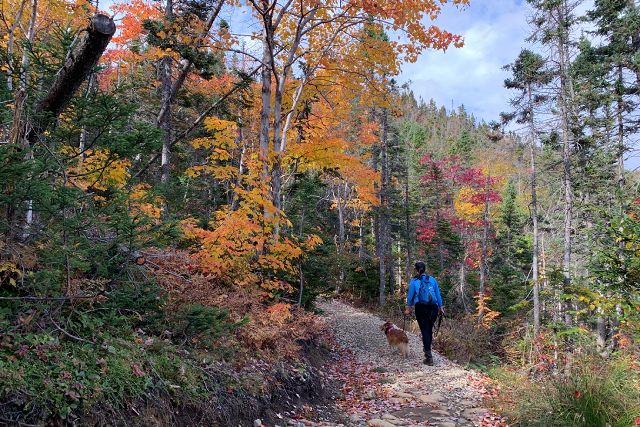
Boreal forests
Gros Morne National Park
Forests are home to much of the world’s biodiversity. Trees, shrubs, flowers, mosses, lichens, and fungi create the complex structure of the forest. Mammals, birds, insects, and countless microscopic organisms find food and shelter in the diverse habitats that occur within the forest. All these elements interact with each other, and together create the complex ecosystem that they inhabit.
The boreal forest, or Taiga, is dominated by conifer trees and is the Earth’s largest terrestrial biome. It encircles the northern hemisphere in a broad zone south of the treeline. It is characterized by short summers and long, cold winters having persistent snow. It is an ecosystem defined by change that requires periodic disturbances to maintain its health. Boreal forest covers more than half of Canada. It stretches from the Yukon and northern British Columbia to Newfoundland and Labrador, including the northern latitudes of most provinces.
Boreal forest ecoregions of Gros Morne

Almost half of Gros Morne National Park (44%) supports boreal forest. Because of the interplay between the Gulf of St. Lawrence and the Long Range Mountains, the climate of Gros Morne is cool and wet, and forest fires are rare. Instead, insect outbreaks and powerful winds that topple trees are the main agents of forest renewal.
These disturbances open gaps in the forest that let sunlight reach the ground, stimulating rapid growth by sun-loving plants. Young trees that have waited patiently in the shade quickly fill these gaps, creating dense young forest that provides cover and food for many species of wildlife.
Standing and fallen dead trees also support many specialized species, including wood-consuming insects and fungi, as well as woodpeckers and other tree cavity users. These cycles of disturbance and renewal typically affect stands at 80 to 140 year intervals and have been shaping the forest in western Newfoundland for millennia. Consequently, the boreal ecosystem in Gros Morne is dynamic, resulting in a diverse landscape characterized by a tapestry of young and old patches of forest.
Most of the forest in Gros Morne National Park is dominated by conifers, and the cool, wet climate provides ideal conditions for balsam fir to thrive, leading to the prevalence of this tree species throughout much of the park. Black spruce and white spruce are also common, and even dominant on some sites. White birch, also known as paper birch, is the most abundant and widespread deciduous tree, and occurs in low numbers in most conifer-dominated stands. However, white birch, trembling aspen, and eastern larch can also form mixed wood stands with fir and spruce trees, or even be dominant on some sites.
Despite the prevalence of a small number of tree species, climate and soils vary considerably and three distinct forest ecoregions are represented in Gros Morne National Park.
1. Western Newfoundland forest ecoregion

The Western Newfoundland forest ecoregion encompasses the southern lowland portion of the park around Bonne Bay. It is characterized by a humid climate, relatively long growing season and nutrient rich soils. The productive fir-dominated forest in this ecoregion is noted for its vigorous regeneration and in the past supported a large sawmill at Lomond.
Several southern boreal trees reach their northern limit in this ecoregion, including yellow birch, red maple, pin cherry, black ash, and eastern white pine, but they are all relatively uncommon and only locally abundant. The Lomond, Stanleyville, and Stuckless Pond trails offer good opportunities to experience the rich, diverse forest of this ecoregion.
2. Northern Peninsula forest ecoregion

The Northern Peninsula forest ecoregion includes the coastal lowlands north of Bonne Bay and extends to the foothills of the Long Range Mountains. This ecoregion is characterized by a shorter growing season. The land here is a matrix of extensive peatlands and scrub forest interspersed with productive forest on well-drained ridges.
Like the Western Newfoundland ecoregion, balsam fir is the dominant tree species, and black spruce and eastern larch are also common, especially on wet soils. The Western Brook Pond trail offers an excellent opportunity to experience this ecoregion.
3. Long Range Barrens ecoregion

The Long Range Barrens ecoregion occupies the eastern half of the park and is restricted to the highlands of the Long Range Mountains at elevations above 400 meters. Much of this region lies above the tree line. The climate is cool and windy with deep, persistent snow cover, and short growing seasons.
The dominant tree cover is wind-shaped scrub (Krummholz) comprised of fir and black spruce, locally known as ‘tuckamore’. Productive fir forest is found in sheltered valleys and becomes more common towards the eastern boundary of the park.
In contrast to the typical pattern found throughout the lowlands of Gros Morne national park, in these high elevation forests, the harsh climate has prevented insect outbreaks. This has led to the development of mixed-age, old-growth forests having fir trees up to 250 years old, as well as distinct wildlife communities. While the Long Range Traverse is the best way to experience this ecoregion, it can also be enjoyed along the upper portions of the Gros Morne Mountain trail and the Lookout trail.
Related links
- Date modified :